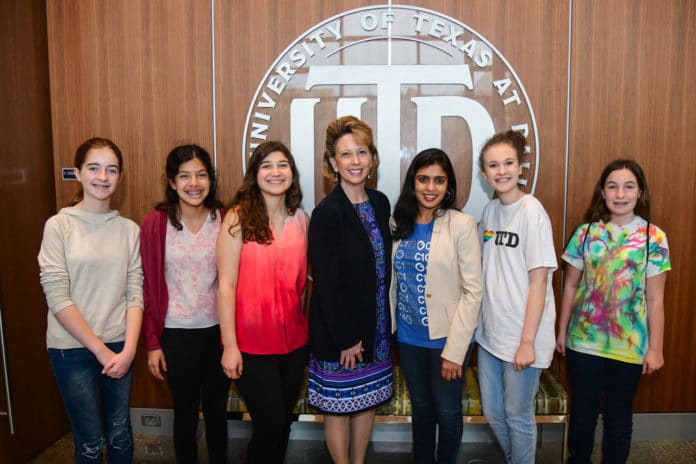UT Dallas
https://innovation.utdallas.edu/girls-going-places
In response to the dearth of women and girls in science, technology, engineering and math (STEM), Capital One and The University of Texas at Dallas’ Institute for Innovation and Entrepreneurship partnered to co-sponsor an event to change those persistently low participation rates.
The conference, titled The Innovate(her), was held March 27 at the UT-Dallas Davidson Gundy Alumni Center. Capital One associates and UT-Dallas students mentored and worked with about 75 middle school girls from Allen, Dallas, Frisco, Lewisville, Lovejoy and Richardson school districts.
The aim was to inspire and motivate girls to be curious and explore STEM topics and consider STEM academic opportunities and career paths. The day’s events included four modules for the girls to experience: design thinking, personal finance basics, personal branding and technology.
Programs such as Women in Tech and Innovate(her) are part of Capital One’s Future Edge Initiative, which aims to help Americans harness the skills, tools and resources necessary for success in the 21st century.
“We’ve really partnered to make [Dallas-Fort Worth] an ecosystem where it’s a technology leader. We’ve also really focused in on building tomorrow’s leaders and tomorrow’s tech talent,” said Monica Shortino, director of social innovation at Capital One. “This program really brings all of that together.”
Shortino explained that the goal of the conference was to have girls walk away with some inspiration to go into STEM fields.
“We are hoping that it really sparks those interests and that following today’s session they’ll continue to dive into technology fields and creative fields to be tomorrow’s leaders.”
Sarah Troxell, Capital One product management manager, led the design thinking module, in which students were assigned to work together as a table team to design a chair for a specific customer. They were given a card with a customer profile to lead them in the design process.
When thinking about design, Troxell told the girls, start with the customer’s needs and emotions and from there get your idea, which turns into a prototype that then goes through testing and various iterations. That is how you get to your final product.
Students identified the customer’s needs, then sketched a preliminary design and made prototypes with cardboard cutouts and pipe cleaners.
Ja’mya, an eighth grader at Dallas ISD’s E.B. Comstock Middle School, said her team had to design a comfortable chair for a soccer player who had sore muscles.
“We made a fluffy chair that’s a recliner that will have support and can massage,” Ja’mya said.
Asked whether she would want to come to the second Innovate(her) event, Ja’mya nodded excitedly.
“I like that this event has a lot of engineering because I like building and designing things,” she said. “I want to be an entrepreneur and so I need to learn these skills.”
Melissa Beaumont with the group Plano Moms led the personal finance basics activity. She distributing 20 Smarties (candy) to every student, who then had to allocate them on a budgeting worksheet with categories (such as transportation) and various smarties “pricing” options (such as a new car versus a used one).
Students Ellie and Gracie from Allen ISD’s Lowry Freshman Center found themselves making “tough sacrifices” as they lost and gained Smarties for their budget based on Beaumont’s scenarios such as getting a raise or breaking a leg and having no health insurance.
Gracie eventually chose to live with relatives rather than in a house she owned so she could spend the saved smarties on Netflix.
“Adulting is difficult!” she exclaimed at the end of the exercise. Ellie nodded in agreement and laughed.
“I’m going to leech off my parents as long as I can!” she declared.
Capital One technology leader Mithra Kosur Venuraju was the conference keynote speaker.
In her career, Venuraju said, her priority is having diverse perspectives on all the teams she builds. That wasn’t necessarily the case when she joined her 12-person team at Capital One as the only woman.
In her early schooling, Venuraju said, she saw that girls and boys had equal opportunities for STEM education. However, in middle and high school she noticed girls becoming disengaged from the STEM fields.
So Venuraju set out to help change that. She started by joining Capital One’s Women in Tech program, which the company began in 2014 to bring women and men together to work to improve women’s representation in technology, support women in tech career development and develop a love of innovation and technology in women and girls.
“Innovation doesn’t always have to be super big. For me innovation is a state of mind. I define innovation as creative ways to solve everyday problems and challenging people’s views to come up with new ways of thinking,” Venuraju continued. “After you all leave here today, I hope you will feel inspired and empowered to follow your dreams.”
There little doubt of the need for programs like Innovate(her). In 2015, women filled 47 percent of all U.S. jobs, but they held only 24 percent of STEM positions, according to a 2017 report from the Office of the Chief Economist in the U.S. Economics and Statistics Administration.
Women constitute slightly more than half of college-educated workers but make up only 25 percent of college-educated STEM workers, the report said.






